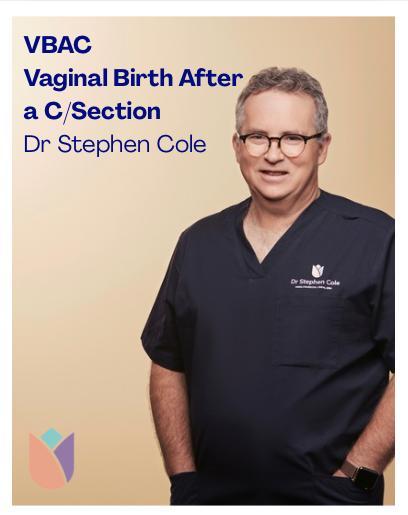Can I Have a Vaginal Birth After a C‑Section?
You Absolutely Can — And It's Okay to Explore That Option
If you’ve had a previous caesarean and are wondering whether a vaginal birth is possible—or even right for you—the answer may well be yes!
VBAC can be achievable, and is generally safe for you and your baby, however there are some important things to consider. Here’s a gentle and helpful guide to VBAC (Vaginal Birth After Caesarean) to support you in making the decision that feels best.
I am very happy to support women attempting VBAC, and will work with you to make sure you are informed of all of your options, and have a balanced discussion regarding the pros and cons of different choices.
What Is VBAC and What Awaits with Labour?
When you go into labour after a previous C‑section, that’s called a Trial of Labour After Caesarean (TOLAC). If everything goes well and you birth vaginally, that’s a successful VBAC. If all goes smoothly it looks very much like any vaginal birth, but with a bit more monitoring to keep things safe and smooth for both of you.
That’s because continuous fetal heart rate monitoring and an IV line may be used—not to restrict your experience, but to ensure we can notice any early signs of concern and respond quickly if needed.
What Makes VBAC an Appealing Option for Many Women?
Recovery is easier: Most successful VBACs mean less pain, a faster recovery, and more energy to care for yourself and connect with your baby earlier on. This is particularly important if you already have a toddler at home who will also require your care.
- Benefits for your future pregnancies: Fewer surgeries mean lower risks of complications like placenta accreta or adhesions in later pregnancies.
- Baby’s smooth start: Vaginal birth supports newborn breastfeeding and bonding, and some parents feel more empowered by a birth experience that aligns with their personal hopes and goals, creating a positive birth experience.
What Are the Risks?
The risks of attempting a vaginal birth are important and serious, but thankfully they are very uncommon – especially with the right support.
- The main risk is uterine rupture, which happens in a small percentage of VBAC attempts. While serious, it’s rare, and we watch closely for early signs through monitoring and IV access.
- Some mums planning VBAC end up needing a C‑section, typically because labour slows or the baby shows signs of needing help.
- If that happens unexpectedly, emergency surgery can carry slightly higher risks than a planned one—but we prepare for it and act quickly if needed.
Remember that these risks also need to be balanced against the risks of having an elective caesarean section. If you are considering attempting a VBAC you will need to understand and consider the risks and benefits of both TOLAC / VBAC and elective caesarean section. This is something we will discuss in detail.
If you would like to read more around the specific risks of vaginal birth after caesarean, a good summary can be found at the Royal Australian and New Zealand College of Obstetricians and Gynaecologists (RANZCOG) website: RANZCOG Best Practice Statement: Birth after previous caesarean section.
https://ranzcog.edu.au/wp-content/uploads/Birth-After-Previous-Caesarean-Section.pdf
Who’s a Good Candidate for VBAC?
You are more likely to succeed at VBAC if:
- You had a previous low-transverse C‑section (our most common type of scar). If you have previously had a Classical C-section it is generally NOT safe to attempt a VBAC
- You’ve had a previous vaginal birth
- Your pregnancy is low-risk, with your baby in head-down position and is normally grown
Even if some factors lower your chance—like labour induction, a larger baby, or a higher BMI—they don’t automatically rule out VBAC. It just means a more personalised discussion about your options.
Is VBAC Always Offered?
Not automatically—availability depends on your hospital and your care team. Safe VBAC requires facilities ready for emergency support and continuous monitoring.
That’s why I recommend early conversations—ideally in your first or second trimester—about your uterine scar, your birth hopes, and the policies of your chosen hospital and team.
In my Melbourne practice, whether at Epworth Freemasons, St Vincent’s Private, or Frances Perry House, we are equipped and prepared to support VBAC if you make that choice.
How I Support You in This Journey
- Listening to your wishes first: I take time to hear your story, past experience, and what matters most to you.
- Full counselling on pros and cons of VBAC vs elective C‑section—personalised to your situation and circumstances.
- Clear hospital planning, arranging birth in a centre ready for VBAC if that’s your path.
- Supportive labour environment: Continuous monitoring, pain relief choices (including epidural if you would like it), and preparedness for all scenarios.
- Ongoing trust and teamwork, building trusting relationships, having on-going discussions about choices and scenarios as your pregnancy unfolds – especially where circumstances change.
At my practice, with a caring team that includes supportive midwives and a physiotherapist, we aim to make your transition from pregnancy to new motherhood feel well‑supported and positive.
Final Thoughts — Your Birth, Your Way
If a vaginal birth after caesarean speaks to your hopes, and it is safe for you and your baby, VBAC can absolutely be an achievable and empowering choice.
Whether you end up with VBAC or opt for a planned repeat C‑section—we’re here to support you fully. What matters most is that you feel safe, informed, and respected in your decision.
Let’s chat soon about what’s right for you. Together, we’ll build a birth plan based on your history, your hopes, and the safety of you and your baby.
You're in caring hands — Dr Stephen Cole
